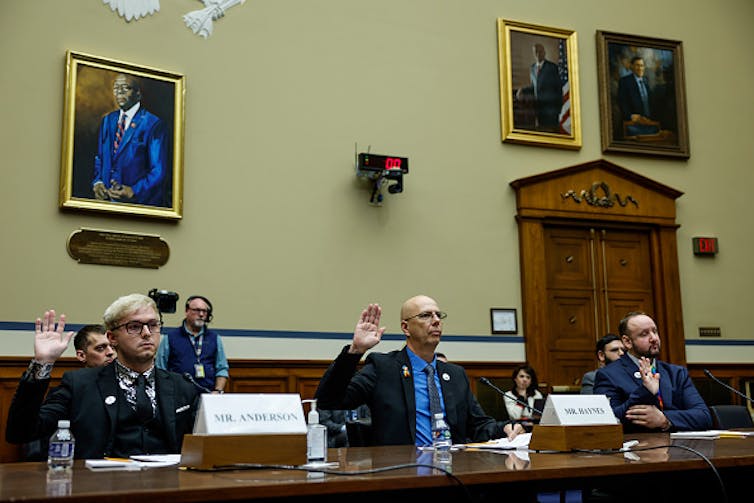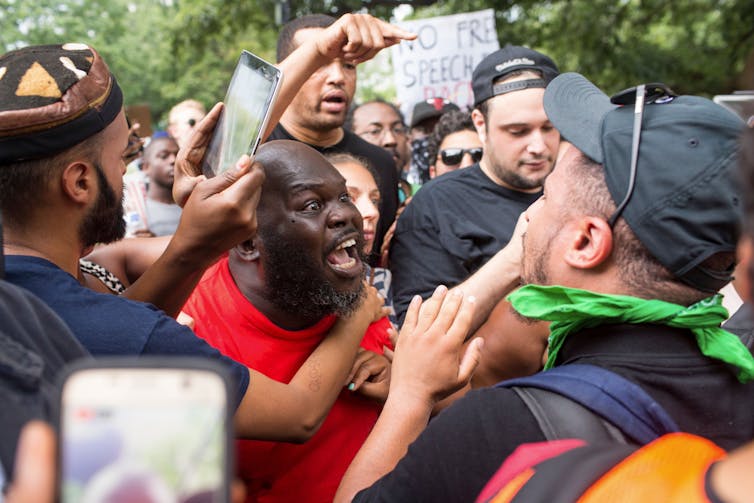
Events like the riots in Brazil, the Jan. 6, 2021, insurrection two years before it and the mass shooting at the Colorado LGBTQ nightclub each occurred after certain groups repeatedly directed dangerous rhetoric against others. It’s the reason elected officials in the U.S. have begun examining the role language plays in provoking violence.
As a social psychologist who studies dangerous speech and disinformation, I think it’s important for citizens, legislators and law enforcement alike to understand that language can provoke violence between groups. In fact, there are different types of threat in rhetoric that in-groups – people we identify as “us” – use to trigger violence, against out-groups – people we perceive as “them.”

In my research, I call dangerous speech that paints outsiders as threats “threatoric.” Using this type of dangerous speech allows in-groups to justify violence as a defense against out-groups. For instance, recent polls indicate that 40% of people who primarily consume far-right news sources believe that “true patriots” may have to resort to violence to “save” the country. Former Missouri Gov. Eric Greitens parroted this sentiment in a campaign ad while he was seeking the Republican nomination for a U.S. Senate seat. In the ad, Greitens called for allies to “Get a RINO (Republican in Name Only) hunting permit. There’s no bagging limit. No tagging limit. And it doesn’t expire – until we save our country.”
Drawing on an array of scientific theories that recognize the key ingredients driving conflict between groups, I have identified five basic types of threatoric.
1. Physical threats – They are going to harm us
Threatoric that paints the out-group as likely to physically harm or kill members of the in-group falls into this category. For example, in-groups sometimes use disease to paint the out-group as a threat to the in-group’s physical well-being. The accusations people lodged against Asian Americans and immigrants throughout the COVID-19 pandemic are examples.
In-groups also cast out-groups as physically aggressive or violent criminals for the same reason. Masters of threatoric are particularly fond of portraying out-groups as predators of our society’s protected or vulnerable – groups like women, children and the elderly. Such characterizations make the out-group seem deplorable and action to “protect” the vulnerable seem noble.
Periodically, from as far back as the Middle Ages, different in-groups have leveled so-called “blood libels” against Jews, alleging the murder of Christian children as a part of a ritual. Today, we see echoes of this in QAnon conspiracy theories that accuse liberals of trafficking children. As a consequence, QAnon believers want to “save the children” and are willing to use violence to deal with the alleged threat.
2. Moral threats – They are degrading our society
Someone in an in-group who perceives the out-group as degrading society’s cultural, political or religious values casts the out-group as a moral threat.
For example, people frequently target members of the LGBTQ community with this sort of threatoric. Some believe homosexuality is morally wrong. And there are people who argue same-sex marriage poses a danger to marriage itself. During the previous Congress, a Republican congresswoman crying on the House floor before the chamber signed the Respect for Marriage Act is one case in point. People have blamed the alleged immorality of the LGBTQ community for everything from natural disasters to terror attacks. And accusations that LGBTQ people are indoctrinating and grooming children are mainstays of political threatoric increasingly peddled today.
Florida’s new Parental Rights in Education bill, controversially called the Don’t Say Gay bill by some opponents and the Anti-Grooming bill by some proponents, prohibits teachers from discussing sexual orientation or gender identity in certain classrooms.
3. Resource threats – They are taking from us
Sometimes, members of the in-group portray the out-group as a competitor for valued goods. We see this in the classic Robber’s Cave Experiment, in which boys attending a summer camp were arbitrarily divided into two groups – Rattlers and Eagles – and made to compete for valued resources. Animosity and conflict between the groups grew quickly.
To amplify perceptions of resource threats, people often play up the perception that access to resources is a zero-sum game. If the out-group gets access to the desired resource, it will mean little to nothing is left for the in-group. The most common example in this type of threatoric is the accusation that immigrants are “stealing our jobs.” This threat can be extended to casting the out-group as receiving an unfair share of other resources, like education, scholarships, health care or social services.
4. Social threats – They are obstacles to us
When members of the in-group blame the out-group for costing the in-group social status or access to important relationships, they are employing social threats. This can be triggered by demographic shifts in population. Alternatively, when in-group members view their status as undesirable, they can look to an out-group to blame. There are often themes of entitlement in this rhetoric, in which the speaker feels he is owed a certain social standing or relationship. For instance, among the Incel movement, a subculture of involuntarily celibate people – mostly men – rage against women for denying them sexual relationships is common. This rage can have lethal consequences, as in the 2018 shooting during a yoga class in Tallahassee, Florida. A man killed two women and injured six others.

5. Self threats – They make us feel bad
Lastly, the in-group sometimes feels as if its collective self-esteem is threatened by the out-group, such as when they perceive that the out-group is dehumanizing them. This can lead to thinking along the lines of “they hate us, so we hate them.” Just search for “libtard” or “repugnican” on Twitter for examples. But in this case, the level at which the out-group is perceived as engaging in this derogation is exaggerated and ignores similar behavior by the in-group. The insults hurled by the other group are always cast as worse than any used by the in-group. This threatoric is particularly evident among political partisans.
In some cases, particularly when there has been historic conflict between groups, there is past evidence of a group actually representing a threat. But threatoric minimizes transgressions by the in-group and paints the out-group as essentially toxic to the in-group, threatening anything from their self-image to the lives of those they care about. The greater the perceived threat, the more justified extreme action appears. It becomes an “us or them” narrative.
Numerous studies over decades of research on intergroup conflict have supported this link between perceived threat and hostility and conflict. Even now, we see this playing out in our streets as, for the first time in history, half of all extremist attacks have been occurring during politically polarized demonstrations. We see it in the manifestos of known killers.
In America, we are fond of the idiom, “Sticks and stones may break my bones, but words will never hurt me.” However, we fail to acknowledge that no one throws those sticks and stones without reason. Threatoric gives us that reason.
H. Colleen Sinclair receives funding from Department of Defense & the National Institute of Justice.
This article was originally published on The Conversation. Read the original article.




!["[T]he First and Fifth Amendments Require ICE to Provide Information About the Whereabouts of a Detained Person"](https://images.inkl.com/s3/publisher/cover/212/reason-cover.png?w=600)


